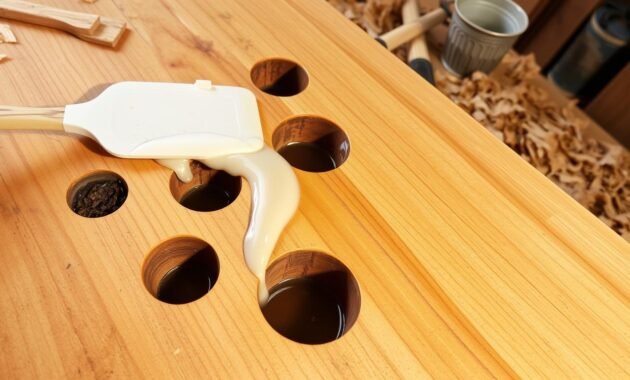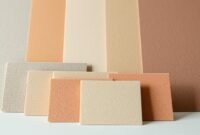Ever looked at a big wood crack or hole and thought it was too much to fix? Damaged wood can be really frustrating. It might ruin your favorite furniture or important woodworking projects.
Traditional wood fillers often don’t work well on big gaps. They leave weak, ugly repairs that fall apart easily.

Epoxy resin is the perfect fix for wood damage. It’s incredibly strong and can fill wood cracks perfectly. I’ll teach you how to use the best wood filler method that pros love.
Read also: Can You Paint Over Stain Wood?
Understanding Epoxy Resin for Wood Repair
Epoxy for wood repair is a powerful solution that makes damaged surfaces strong and durable. As a woodworking enthusiast, I’ve seen how epoxy resin can fix wood holes and restore damaged projects.
Epoxy resin is a two-part compound made of resin and hardener. It’s designed to bond wood projects well and provide structural support. It has 100% solid content and no fillers, which means it shrinks less during the repair.
Types of Epoxy for Wood Filling
- Regular wood filler: Ideal for general repairs and bonding
- Marine epoxy: Water-resistant for outdoor and marine applications
- Thixotropic epoxy: Thick consistency perfect for large gaps and voids
- Clear epoxy: Enhances wood’s natural beauty while providing structural support
Benefits of Using Epoxy in Wood Projects
Epoxy is great for fixing wood holes because of its high tensile strength of 7,100 psi. It’s very durable. This makes the repair process easier to follow.
How Epoxy Bonds with Wood
Epoxy goes deep into wood fibers, creating a waterproof seal that lasts for decades. The tools needed are simple, making it easy for both pros and DIYers. With the right mixing and application, you can get a seamless repair that strengthens and protects your wood.
Remember, proper surface prep and careful application are essential for a successful repair with epoxy resin.
Essential Tools and Materials Needed
Starting a big wood repair job means picking the right tools and materials. Using a strong wood filler like epoxy is key. The right tools help you get professional-looking results.
Here are the must-have tools for fixing wood holes and doing wood repairs:
- Mixing cups with precise measurement markings
- Disposable stirring sticks or wooden spatulas
- Protective gloves and safety glasses
- Precision applicator tools (syringes or small spatulas)
- Masking tape for protecting surrounding surfaces
- Compressed air or soft brushes for surface cleaning
For materials, you’ll need these key items for a good wood epoxy filler job:
- High-quality two-part epoxy resin system
- Matching hardener compatible with your specific resin
- Pigments for color matching (optional)
- Sandpaper in multiple grit levels (60-220 grit)
- Cleaning solvent for surface preparation
Woodworkers often choose brands like Total Boat Epoxy Kit or Industrial Clear epoxy resin. These products work well for big repairs and last a long time.
Pro tip: Buy a little more of everything than you think you’ll use. Wood repair can be tricky. Having extra stuff means you won’t have to stop working.
Preparing Your Workspace and Safety Measures
Before you start fixing wooden surfaces, setting up the right workspace is key. It’s not just about having the right tools. It’s also about keeping safe and working in a place that supports your precision.
When working with epoxy, safety comes first. I’ll show you how to protect yourself and set up the best workspace.
Read also: Try a New Sensation of Painting with Acrylic Paint
Proper Ventilation Requirements
Epoxy gives off strong fumes that can be dangerous. Make sure you work in a place with good air flow. This could be a room with open windows or a workshop with air circulation.
- Open all windows and doors
- Use fans to create cross-ventilation
- Work near an open garage door or outdoor space
- Avoid enclosed, small rooms without airflow
Personal Protection Equipment
Wearing the right gear is essential for safety. It helps prevent health risks and accidents.
| Protection Type | Recommended Equipment |
|---|---|
| Respiratory Protection | N95 respirator mask |
| Eye Protection | Safety glasses or goggles |
| Hand Protection | Chemical-resistant nitrile gloves |
| Clothing | Long-sleeve shirt, long pants |
Surface Preparation Steps
Getting your surface ready is vital for epoxy wood repair. Clean surfaces help the epoxy stick better and look professional.
- Remove dust and debris from the wooden surface
- Clean with denatured alcohol or acetone
- Sand the area lightly with 150-grit sandpaper
- Wipe away sanding dust with a tack cloth
- Use painter’s tape to protect surrounding areas
By following these steps, you’ll be ready to tackle your wood repair project safely and effectively.
How to Fill Large Holes in Wood
Fixing wooden surfaces can be tough, mainly when dealing with big holes or deep cracks. I’ll share the key wood restoration tips for filling these tough spots with epoxy resin.
Before you start, getting ready is important. Here are the essential items you’ll need:
- Industrial Clear epoxy resin
- Painter’s tape
- Mixing containers
- Protective gloves
- Wooden mold or frame (for very large gaps)
Here’s how to tackle wood cracks:
- Clean the wood surface well
- Seal one side with painter’s tape
- For deep holes, make a temporary frame
- Mix epoxy as the instructions say
Using the right pouring method is key for fixing wood. For holes over 1/2 inch deep, pour epoxy in stages to avoid air bubbles. Industrial Clear epoxy resin has great qualities:
| Property | Specification |
|---|---|
| Tensile Strength | 7100 psi |
| Solids Content | 100% (No Fillers) |
| Recommended Project Duration | 2 hours |
| Total Curing Time | 24 hours |
Tip: Make sure the wood is dry before using epoxy to avoid future cracks. Pour a bit above the surface and let it settle. After it’s cured, sand and finish the area for a smooth look.
Mixing and Tinting Epoxy for Perfect Color Match
Getting the right color match is key for a seamless wood repair. Tinting epoxy resin needs precision and careful technique. This is how you effectively repair damaged wood.
Woodworkers have found ways to fill wood cracks perfectly. The trick is to know how to mix and color your epoxy. This way, it blends well with the surrounding wood.
Calculating Proper Ratios
Mixing epoxy correctly is essential for a successful repair. Most professional-grade epoxy resins have specific mixing ratios:
- Standard 1:1 ratio for general wood repairs
- 2:1 ratio for specialized deep wood patch applications
- Always measure components precisely using graduated mixing containers
Adding Pigments and Colorants
There are several ways to color your epoxy resin:
- Artists’ charcoal powder for natural wood tones
- Acrylic paints in burnt sienna and raw umber
- Powdered pigments for consistent color distribution
- Oil colors for subtle blending
Testing Color Matches
Always test your color match on a small, hidden area before applying it to your whole project. Woodworkers suggest:
- Creating test patches on scrap wood
- Using blend-all sticks for spot repairs
- Mixing tiny amounts of pigment to achieve precise shades
Pro tip: Start with a small amount of pigment when using epoxy resin. Gradually add more until you get the perfect match. Remember, a little goes a long way in creating a natural-looking wood repair.
Applying Epoxy to Wood Voids

Fixing large holes in wood needs precision. The right technique and epoxy resin are key. I’ll show you how to apply epoxy to deep wood patches.
For a strong repair, it’s important to pour and spread the epoxy well. Industrial Clear epoxy resin is great because it doesn’t shrink. It also has a high tensile strength, making it perfect for wood repairs.
- Choose a medium viscosity epoxy for best wood absorption
- Prepare to work in layers for deep holes
- Use precise application tools like syringes or droppers
- Allow sufficient time for epoxy to settle into cracks
For deep holes, apply epoxy in thin layers, no more than 1/4 inch. This avoids overheating and cracking. Let each layer cure before adding the next for a solid repair.
| Epoxy Application Technique | Recommended Method |
|---|---|
| Layer Thickness | Maximum 1/4 inch per layer |
| Curing Time Between Layers | Allow full cure before next application |
| Total Repair Time | Approximately 2 hours active work |
| Total Curing Time | 24-48 hours recommended |
Pro tip: Overfill the wood void for full coverage. This method creates a smooth surface that shows off the wood’s beauty and strength.
Techniques for Preventing Air Bubbles
When fixing damaged wood and filling big holes, stopping air bubbles is key. Professional woodworkers know that air can ruin the look and strength of epoxy fills.
Air bubbles are a big problem with epoxy resin. Most bubbles come from wood that isn’t sealed well. I’ve found ways to cut down on these air pockets.
Using Heat Guns and Torches
Heat is a great tool for fixing wood. Warming epoxy to 75-80°F makes it thinner. This helps bubbles come up faster. Here’s how to use heat:
- Use a heat gun at a low setting
- Quickly pass a torch flame over the surface
- Apply heat multiple times during the filling process
Multiple Layer Applications
For deep holes and big repairs, use thin layers of epoxy. This stops air from getting trapped and makes sure it fills well.
| Layer Technique | Benefits |
|---|---|
| Thin Layer Application | Reduces bubble formation |
| Partial Curing Between Layers | Improves structural integrity |
| Low-Viscosity Epoxy | Enhanced wood fiber penetration |
Working with Deep Holes
Deep repairs need extra care. Use epoxy that’s easy to get into wood fibers. Sealing the wood first and using heat can help a lot.
Curing and Drying Process
Using epoxy resin for wood repair is a great choice. But, knowing how to cure it is key. The curing time and conditions can affect your repair’s success.
Temperature is very important for curing epoxy. I suggest keeping the room at 70-85°F (21-29°C). Humidity and the environment also play a big role in how fast and even the epoxy sets.
Key Curing Considerations:
- Initial touch-dry time: Approximately 24 hours
- Full cure time: Up to 7 days
- Recommended room temperature: 70-85°F
When filling wood cracks with epoxy, be patient. Industrial Clear epoxy has no fillers, which means less shrinkage. It’s also very strong, with a tensile strength of 7100 psi.
Curing Precautions:
- Avoid direct UV light exposure
- Keep temperature below 190°F (88°C)
- Ensure proper ventilation
After 24 hours, your epoxy will be touch-dry. But, wait the full seven days for the best strength and durability. Only then can you use the wood again or add more finishes.
Finishing and Sanding Methods
After fixing large holes with epoxy resin, the right finishing techniques are key. They make your repair look professional. With the right steps, a damaged piece of wood can become smooth and look new again.
Progressive Grit Sequences for Smooth Results
For deep wood patches, a careful sanding plan is essential. Start with coarse-grit sandpaper and move to finer grits. Here’s a good sanding sequence:
- Begin with 80-grit sandpaper to remove excess epoxy
- Move to 120-grit to smooth initial rough surfaces
- Progress to 220-grit for a more refined finish
- Finish with 400-grit for an ultra-smooth surface
Surface Leveling Techniques
Getting a perfectly level surface is important. Use a hand plane or card scraper to fix uneven spots. For bigger projects, a thickness planer can make the surface completely flat.
Final Polish Steps
The final step is to achieve a flawless finish. After sanding, apply a seal coat or flood coat for protection. Lightly sand between coats for extra smoothness. Always remove sanding dust to avoid imperfections in the finish.
Pro tip: Practice on a scrap piece first. This helps you get your technique right before working on your main project.
Maintenance and Care Tips

After fixing your wooden surface, keeping it in good shape is key. I’ll share some tips to help you care for your repaired wood.
First, let the epoxy cure for seven full days before using the wood again. This step is important to avoid damage.
- Protect from extreme environmental conditions
- Avoid direct UV light exposure
- Maintain consistent temperature
- Clean regularly with mild detergent
Regular checks are vital for your wood repair. Look for wear or issues in the epoxy-filled areas. For small damage, a light sand and a thin epoxy coat can fix it.
| Repair Type | Inspection Frequency | Recommended Action |
|---|---|---|
| Minor Surface Damage | Every 6 months | Light sanding, thin epoxy reapplication |
| Significant Structural Damage | Annually | Complete epoxy removal and reapplication |
For big holes, you might need to remove and reapply epoxy. Remove the old epoxy, clean well, and then apply new epoxy to fix it.
By following these tips, your wood repair will last longer and look great.
Conclusion
I’ve shown you how to fix wood with epoxy, from the basics to advanced techniques. Epoxy resin is great for fixing big holes in wood. It makes damaged wood look new again.
Success in wood repair comes from being patient and precise. Choose the right epoxy and prepare your space well. Pay close attention to every step, from mixing the right color to letting it cure properly.
Epoxy wood repair is more than just fixing damage. It’s about keeping and improving wood’s beauty. Whether it’s furniture, floors, or decorations, these techniques can make your wood look great and last long.
Don’t worry if your first try doesn’t turn out perfect. With each project, you’ll get better at using epoxy. Soon, fixing wood will become a fun and rewarding hobby.


